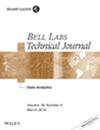Wolfgang Pöhlmann, Bernhard Deppisch, Thomas Pfeiffer, Carlo Ferrari, Mark Earnshaw, Alex Duque, Robert L. Farah, Joe Galaro, James Kotch, Man Fai Lau, Doutje T. van Veen, Peter Vetter
下载PDF
{"title":"基于波长集分复用的低成本TWDM","authors":"Wolfgang Pöhlmann, Bernhard Deppisch, Thomas Pfeiffer, Carlo Ferrari, Mark Earnshaw, Alex Duque, Robert L. Farah, Joe Galaro, James Kotch, Man Fai Lau, Doutje T. van Veen, Peter Vetter","doi":"10.1002/bltj.21633","DOIUrl":null,"url":null,"abstract":"<p>After extensive comparison of candidate technologies, the Full Service Access Network (FSAN) Group in early 2012 made the decision to define Time/Wavelength Division Multiplexing (TWDM) as the primary solution for the next-generation passive optical network (NG-PON2). A minimum of four wavelengths are foreseen as providing a total capacity per feeder line of 40 Gbit/s downstream and 10 Gbit/s or more upstream. Conventional wavelength division multiplexing (WDM) lasers from core or metro networks are too expensive for fiber to the home (FTTH) systems, because every optical network unit (ONU) will need a tunable laser for upstream transmission. In this paper we will compare different technical solutions and present wavelength-set division multiplexing (WSDM), a scheme developed by Bell Labs as the preferred solution for cost reasons. WSDM uses a laser that can be tuned by an on-chip heater stripe. To exploit this partial wavelength tunability, we do not use contiguous wavelength bands, but wavelength-sets consisting of cyclic interleaved wavelength slots on a fine grid. This wavelength plan can be implemented, e.g., by a cyclic arrayed waveguide grating (AWG) with a small free spectral range. We will describe the concept in detail and report on its experimental validation. © 2013 Alcatel-Lucent.</p>","PeriodicalId":55592,"journal":{"name":"Bell Labs Technical Journal","volume":"18 3","pages":"173-193"},"PeriodicalIF":0.0000,"publicationDate":"2013-11-27","publicationTypes":"Journal Article","fieldsOfStudy":null,"isOpenAccess":false,"openAccessPdf":"https://sci-hub-pdf.com/10.1002/bltj.21633","citationCount":"8","resultStr":"{\"title\":\"Low Cost TWDM by Wavelength-Set Division Multiplexing\",\"authors\":\"Wolfgang Pöhlmann, Bernhard Deppisch, Thomas Pfeiffer, Carlo Ferrari, Mark Earnshaw, Alex Duque, Robert L. Farah, Joe Galaro, James Kotch, Man Fai Lau, Doutje T. van Veen, Peter Vetter\",\"doi\":\"10.1002/bltj.21633\",\"DOIUrl\":null,\"url\":null,\"abstract\":\"<p>After extensive comparison of candidate technologies, the Full Service Access Network (FSAN) Group in early 2012 made the decision to define Time/Wavelength Division Multiplexing (TWDM) as the primary solution for the next-generation passive optical network (NG-PON2). A minimum of four wavelengths are foreseen as providing a total capacity per feeder line of 40 Gbit/s downstream and 10 Gbit/s or more upstream. Conventional wavelength division multiplexing (WDM) lasers from core or metro networks are too expensive for fiber to the home (FTTH) systems, because every optical network unit (ONU) will need a tunable laser for upstream transmission. In this paper we will compare different technical solutions and present wavelength-set division multiplexing (WSDM), a scheme developed by Bell Labs as the preferred solution for cost reasons. WSDM uses a laser that can be tuned by an on-chip heater stripe. To exploit this partial wavelength tunability, we do not use contiguous wavelength bands, but wavelength-sets consisting of cyclic interleaved wavelength slots on a fine grid. This wavelength plan can be implemented, e.g., by a cyclic arrayed waveguide grating (AWG) with a small free spectral range. We will describe the concept in detail and report on its experimental validation. © 2013 Alcatel-Lucent.</p>\",\"PeriodicalId\":55592,\"journal\":{\"name\":\"Bell Labs Technical Journal\",\"volume\":\"18 3\",\"pages\":\"173-193\"},\"PeriodicalIF\":0.0000,\"publicationDate\":\"2013-11-27\",\"publicationTypes\":\"Journal Article\",\"fieldsOfStudy\":null,\"isOpenAccess\":false,\"openAccessPdf\":\"https://sci-hub-pdf.com/10.1002/bltj.21633\",\"citationCount\":\"8\",\"resultStr\":null,\"platform\":\"Semanticscholar\",\"paperid\":null,\"PeriodicalName\":\"Bell Labs Technical Journal\",\"FirstCategoryId\":\"1085\",\"ListUrlMain\":\"https://onlinelibrary.wiley.com/doi/10.1002/bltj.21633\",\"RegionNum\":0,\"RegionCategory\":null,\"ArticlePicture\":[],\"TitleCN\":null,\"AbstractTextCN\":null,\"PMCID\":null,\"EPubDate\":\"\",\"PubModel\":\"\",\"JCR\":\"Q1\",\"JCRName\":\"Engineering\",\"Score\":null,\"Total\":0}","platform":"Semanticscholar","paperid":null,"PeriodicalName":"Bell Labs Technical Journal","FirstCategoryId":"1085","ListUrlMain":"https://onlinelibrary.wiley.com/doi/10.1002/bltj.21633","RegionNum":0,"RegionCategory":null,"ArticlePicture":[],"TitleCN":null,"AbstractTextCN":null,"PMCID":null,"EPubDate":"","PubModel":"","JCR":"Q1","JCRName":"Engineering","Score":null,"Total":0}
引用次数: 8
引用
批量引用

 求助内容:
求助内容: 应助结果提醒方式:
应助结果提醒方式:


